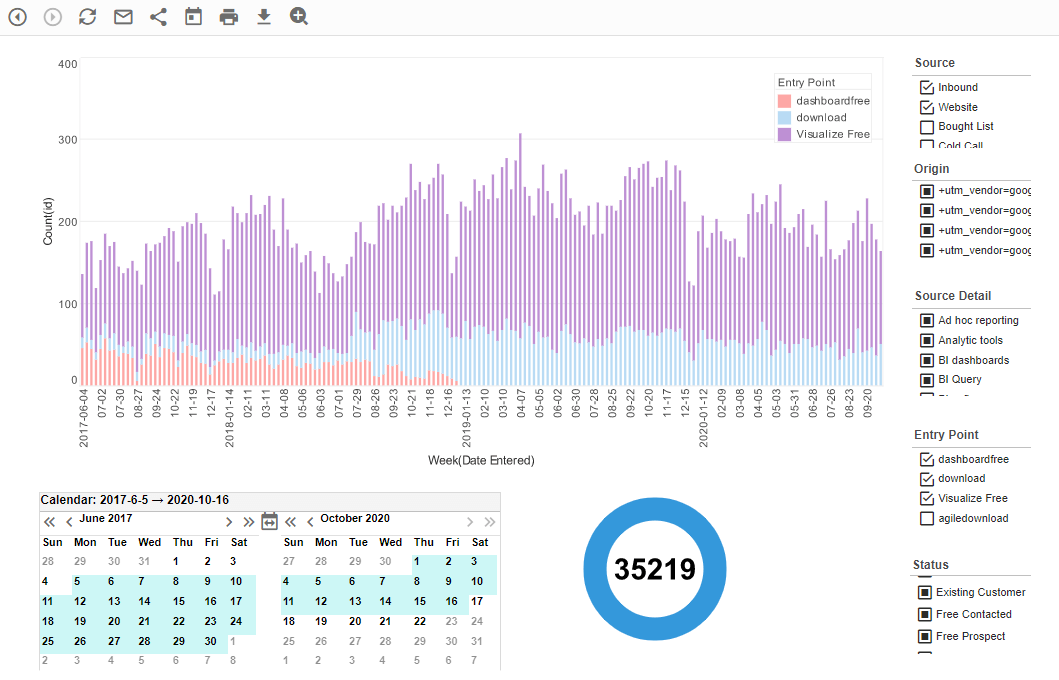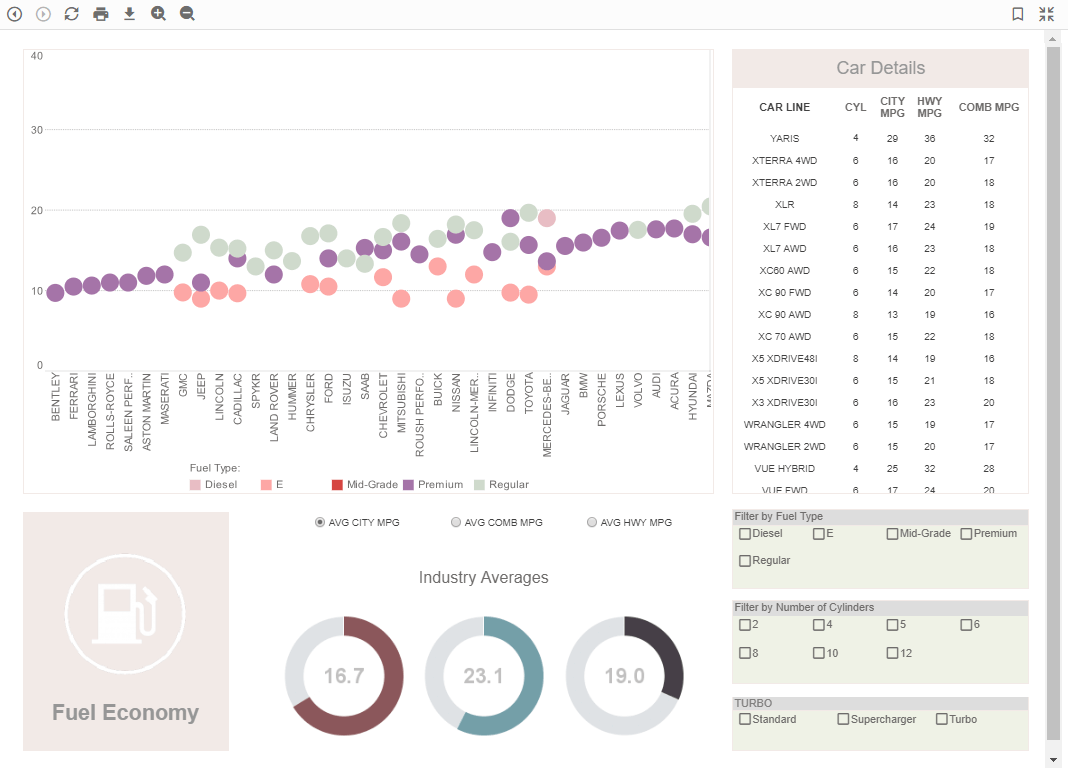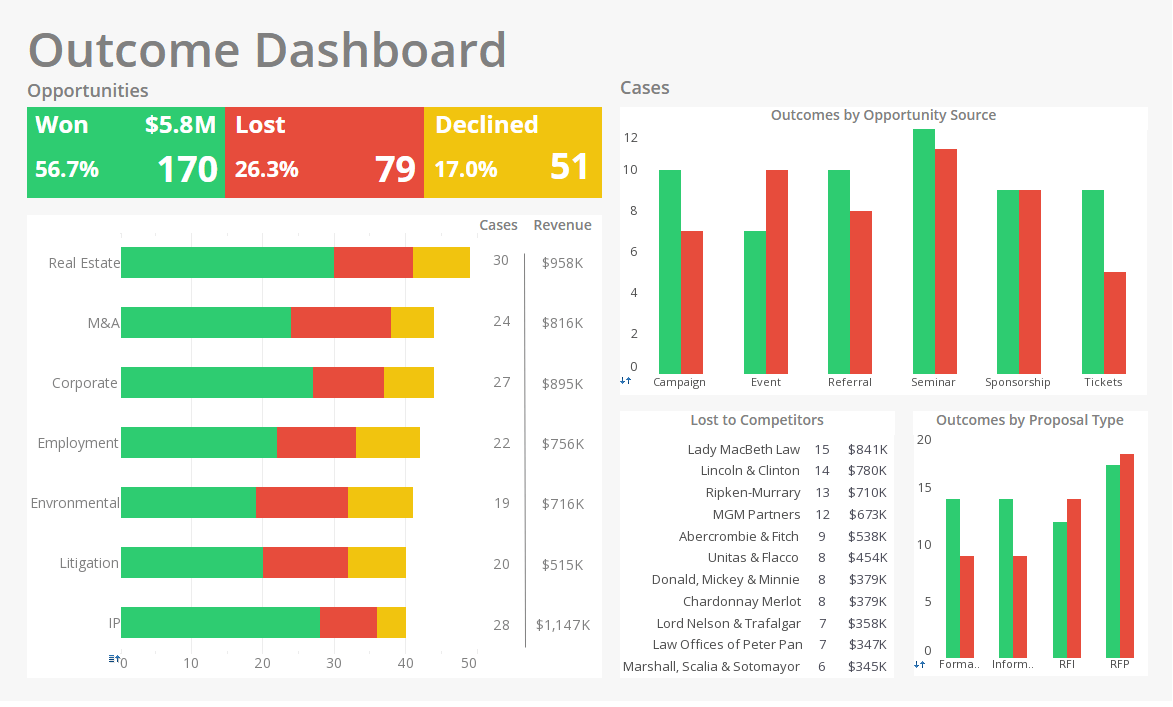Visualization-driven Software for Impromptu Reporting
Today's business users are looking for quick and easy ways to create new reports or visualizations of their data. Rather than the old model of giving time and resource consuming requests to database analysts, IT and business managers are looking for self-service functionality to meet the demands for impromptu reports.
As an innovator in reporting software since 1996, InetSoft has pioneered an evolution towards visualization-driven reporting in response to this need, and its award-winning software has been deployed at thousands of organizations worldwide and integrated into dozens of other application providers' solutions serving vertical and horizontal markets of their own.


InetSoft's Dashboard Reporting Solution
StyleBI is InetSoft's flagship business intelligence platform that provides a dashboard, analysis and reporting solution that is:
Easy:
- Enjoy a rapid implementation; minimum specialized IT expertise required
- Experience a shallow learning curve for business users; only Excel-level skills needed
- Make it easy for analysts & administrators; no SQL experience required
- Scale up with zero-client deployment and no per-user licensing
Agile:
- Provide maximum self-service through ad hoc and visualization analysis
- Enable self-service also at data level: end-user defined data mashup
- Accommodate quick, formal, and experimental changes
Robust:
- Address advanced and mass needs
- Run on a high performance, secure infrastructure
What Are the Drawbacks of IBM Cognos Series 7 Impromptu?
IBM Cognos Series 7 Impromptu was a client-based report authoring tool designed to enable users to create a wide range of reports for business intelligence (BI) purposes. While it was a powerful tool in its time, offering features like frame-based reporting, prompts, picklists, and linked reports, it has several drawbacks, especially when evaluated against modern BI tools and current enterprise needs. Below, we explore these limitations in detail, focusing on technical, usability, support, and strategic challenges.
1. End of Support and Obsolescence
One of the most significant drawbacks of IBM Cognos Series 7 Impromptu is its end-of-support status. IBM announced the withdrawal of support for Cognos Series 7 version 7.5 in a phased approach, with final support ending on April 30, 2018. This means that IBM no longer provides updates, maintenance releases, or fixes for this product. Organizations still using Impromptu face increased risks, as security vulnerabilities remain unpatched, and compatibility issues with modern operating systems and databases are unaddressed. For instance, running Impromptu on newer platforms like Windows Server 2003 or later has been reported to involve potential issues, requiring careful configuration to avoid instability.
The lack of official support forces companies to either rely on costly third-party support providers, such as Origina, or undertake risky upgrade projects to newer versions like IBM Cognos Analytics. Third-party support can mitigate some risks but does not provide the same level of assurance as vendor-backed maintenance, and it comes with additional costs. Upgrading, on the other hand, is complex due to differences in architecture and functionality between Series 7 and modern Cognos platforms, often requiring significant rework of reports and metadata models.
2. Technical Limitations and Instability
Impromptu relies heavily on the Windows COM/OLE API for metadata import and report generation, which introduces several technical challenges. The COM API is notoriously unstable, particularly after repeated failures or when system resources are depleted. This instability often necessitates a Windows reboot to restore functionality, disrupting workflows and reducing productivity. Proper configuration through the Cognos Configuration Manager is critical to ensure the API functions correctly, but this adds complexity to system administration. For example, users must validate and apply settings in the Configuration Manager to register the COM API correctly in the Windows registry, a process prone to errors if not executed precisely.
Additionally, IBM recommends that the Impromptu client and server components not be installed on the same machine due to potential resource conflicts, including those affecting the COM API. This requirement complicates deployment in smaller organizations with limited infrastructure. The software’s dependence on specific Windows user accounts for running as an application or service further increases administrative overhead, as misconfigurations can lead to access issues or API failures.
3. Complex Migration to Modern Platforms
Migrating from Cognos Series 7 Impromptu to newer platforms like IBM Cognos Analytics is a significant challenge. The IBM Cognos Migration Assistant tool can help by reconstructing Impromptu catalogs into metadata models for Framework Manager, but it is not a seamless process. Migration often requires upgrading to a more recent version of Impromptu first to improve compatibility, followed by extensive rework to adapt reports to the new environment. Reports built on manual SQL code may be easier to migrate, but even these require validation and adjustments, as the underlying architecture of Cognos Analytics differs significantly from Series 7.
In some cases, a staged migration—moving from Series 7 to Cognos 10.x and then to Cognos Analytics 11—may be necessary, further increasing time and resource demands. The need for model redesign and report recreation can negate the benefits of automated migration tools, leading many organizations to opt for rebuilding reports from scratch. This process is not only costly but also risks losing critical business logic embedded in legacy reports, especially if documentation is outdated or incomplete.
4. Limited Usability Compared to Modern BI Tools
Impromptu’s user interface and functionality, while advanced for its era, pale in comparison to modern BI tools like Power BI, Tableau, or Qlik Sense. These newer platforms emphasize self-service reporting, enabling end-users to create and customize reports with minimal technical expertise. In contrast, Impromptu requires familiarity with its frame-based reporting interface and multiple components, such as Query Studio and Analysis Studio, which have steep learning curves. This complexity makes it less accessible to business users and places a heavier burden on IT or power users to develop and maintain reports.
Furthermore, Impromptu lacks robust support for offline reporting and mobile access, features that are standard in contemporary BI solutions. While it supports exporting reports to formats like PDF and XML, the process is less intuitive than the seamless integrations offered by modern tools, such as direct connections to cloud-based data sources or real-time dashboards on mobile devices. The absence of advanced visualization options, such as interactive charts or geospatial analytics, further limits Impromptu’s appeal in today’s data-driven environments.
5. Competitive Disadvantages in the BI Market
The BI market has evolved significantly since the release of Cognos Series 7, with tools like Power BI and Tableau dominating due to their ease of use, affordability, and integration with cloud ecosystems. Impromptu, as part of an older suite, struggles to compete. For example, Power BI’s inclusion in Microsoft Office 365 bundles has made it a cost-effective choice for many organizations, while Impromptu’s licensing and maintenance costs remain high, especially for unsupported versions. Discussions on platforms like Reddit highlight a perception that Cognos, including Impromptu, is a “dying tool” with limited market share compared to newer alternatives.
Impromptu also lacks native support for its own ETL (Extract, Transform, Load) tool, unlike competitors such as SAP Business Objects, which integrates with SAP Data Services. This forces organizations to rely on separate ETL solutions, increasing complexity and costs. The fragmented nature of Cognos Series 7, with its multiple tools for different functions (e.g., DecisionStream for ETL, PowerPlay for OLAP), contrasts with the unified, user-friendly interfaces of modern BI platforms.
6. Maintenance and Administrative Overhead
Maintaining an Impromptu environment is resource-intensive. The software’s client-server architecture requires dedicated infrastructure and skilled administrators to manage servers, user accounts, and security settings. Regular maintenance tasks, such as applying patches or troubleshooting COM API issues, demand specialized knowledge that is increasingly scarce as expertise in Series 7 wanes. Organizations face challenges finding personnel familiar with Impromptu, as newer BI tools attract talent and training resources.
Security management is another concern, as Impromptu’s older architecture may not align with modern compliance requirements, such as GDPR or CCPA. Without updates to address emerging threats, organizations must implement additional safeguards, further increasing operational complexity. The need to maintain legacy systems while planning for migration or modernization diverts resources from strategic initiatives, putting companies at a competitive disadvantage.

